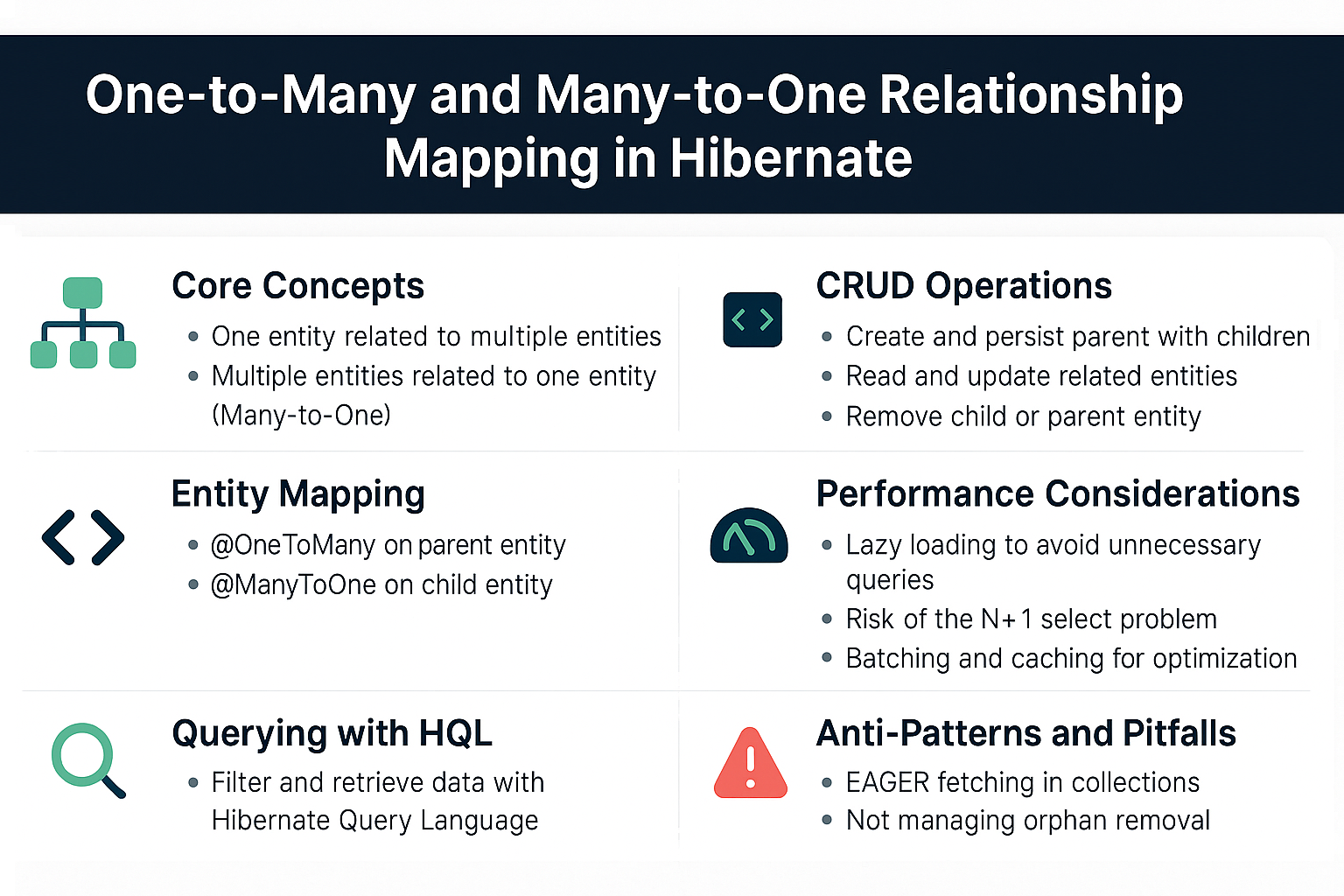When working with real-world databases, entities rarely exist in isolation. For example, a department has many employees, and each employee belongs to one department. Such relationships are fundamental in object-oriented design and relational database modeling.
In Hibernate, these relationships are represented with One-to-Many and Many-to-One mappings. Mastering these mappings helps developers build efficient, maintainable, and production-ready applications where data integrity and performance are critical.
This tutorial explores everything from basic setup to advanced best practices, with real-world Java code, SQL outputs, and performance considerations.
Core Concepts
One-to-Many
- Represents when one entity is associated with multiple entities.
- Example: One Department → Many Employees.
Many-to-One
- Represents when many entities are associated with one entity.
- Example: Many Employees → One Department.
Project Setup
Maven Dependency
<dependency>
<groupId>org.hibernate.orm</groupId>
<artifactId>hibernate-core</artifactId>
<version>6.4.4.Final</version>
</dependency>
<dependency>
<groupId>com.h2database</groupId>
<artifactId>h2</artifactId>
<scope>runtime</scope>
</dependency>
Hibernate Configuration (hibernate.cfg.xml)
<!DOCTYPE hibernate-configuration PUBLIC
"-//Hibernate/Hibernate Configuration DTD 3.0//EN"
"http://hibernate.sourceforge.net/hibernate-configuration-3.0.dtd">
<hibernate-configuration>
<session-factory>
<property name="hibernate.connection.driver_class">org.h2.Driver</property>
<property name="hibernate.connection.url">jdbc:h2:mem:testdb</property>
<property name="hibernate.connection.username">sa</property>
<property name="hibernate.connection.password"></property>
<property name="hibernate.dialect">org.hibernate.dialect.H2Dialect</property>
<property name="hibernate.hbm2ddl.auto">update</property>
<property name="show_sql">true</property>
</session-factory>
</hibernate-configuration>
Entity Mapping
Department Entity (One-to-Many)
@Entity
@Table(name = "departments")
public class Department {
@Id
@GeneratedValue(strategy = GenerationType.IDENTITY)
private Long id;
private String name;
@OneToMany(mappedBy = "department", cascade = CascadeType.ALL, orphanRemoval = true)
private List<Employee> employees = new ArrayList<>();
// Getters and Setters
}
Employee Entity (Many-to-One)
@Entity
@Table(name = "employees")
public class Employee {
@Id
@GeneratedValue(strategy = GenerationType.IDENTITY)
private Long id;
private String name;
@ManyToOne(fetch = FetchType.LAZY)
@JoinColumn(name = "department_id")
private Department department;
// Getters and Setters
}
CRUD Operations
Create and Persist
Session session = sessionFactory.openSession();
Transaction tx = session.beginTransaction();
Department dept = new Department();
dept.setName("Engineering");
Employee emp1 = new Employee();
emp1.setName("Alice");
emp1.setDepartment(dept);
Employee emp2 = new Employee();
emp2.setName("Bob");
emp2.setDepartment(dept);
dept.getEmployees().add(emp1);
dept.getEmployees().add(emp2);
session.persist(dept);
tx.commit();
session.close();
SQL Generated:
insert into departments (name) values ('Engineering');
insert into employees (name, department_id) values ('Alice', 1);
insert into employees (name, department_id) values ('Bob', 1);
Read
Department dept = session.get(Department.class, 1L);
System.out.println("Department: " + dept.getName());
dept.getEmployees().forEach(e -> System.out.println(e.getName()));
Update
Employee emp = session.get(Employee.class, 1L);
emp.setName("Alice Cooper");
session.update(emp);
Delete
Employee emp = session.get(Employee.class, 2L);
session.delete(emp);
Querying with HQL
List<Employee> employees = session.createQuery("FROM Employee e WHERE e.department.name = :deptName", Employee.class)
.setParameter("deptName", "Engineering")
.getResultList();
Performance Considerations
- Lazy Loading (default for @ManyToOne): Employees are fetched only when accessed.
- Eager Loading (use cautiously): Can lead to the N+1 select problem.
- Batch Fetching: Use
@BatchSizeto reduce queries. - Caching: Hibernate 2nd level cache can improve performance significantly.
Real-World Integration with Spring Boot
@SpringBootApplication
public class HibernateApp {
public static void main(String[] args) {
SpringApplication.run(HibernateApp.class, args);
}
}
- Add
spring-boot-starter-data-jpadependency. - Configure
application.propertiesinstead ofhibernate.cfg.xml.
Anti-Patterns and Pitfalls
- Using EAGER fetching for collections → leads to performance bottlenecks.
- Forgetting
orphanRemoval=true→ leaves orphaned rows in the DB. - Cascading REMOVE blindly → may delete unintended records.
Best Practices
- Always prefer LAZY fetching unless necessary.
- Use DTOs for projections instead of fetching entire entities.
- Monitor SQL logs for N+1 problems.
- Use batch inserts/updates for bulk operations.
📌 Hibernate Version Notes
Hibernate 5.x
- Relies on javax.persistence package.
- Legacy
SessionFactorysetup.
Hibernate 6.x
- Migrated to jakarta.persistence namespace.
- Improved query API with better support for joins.
- Enhanced SQL generation.
Conclusion
Mastering One-to-Many and Many-to-One mappings in Hibernate is essential for building scalable enterprise apps. With the right fetching strategy, cascading, and integration with Spring Boot, you can achieve both performance and maintainability.
Key Takeaways
- One-to-Many = Parent → Children; Many-to-One = Child → Parent.
- Use proper annotations:
@OneToMany+@ManyToOne. - Prefer lazy loading with batch fetching.
- Avoid anti-patterns like eager fetching everywhere.
- Hibernate 6 modernizes the APIs with Jakarta namespace.
FAQ
Q1: What’s the difference between Hibernate and JPA?
Hibernate is an ORM implementation; JPA is the specification.
Q2: How does Hibernate caching improve performance?
By reducing database roundtrips with first-level and second-level caching.
Q3: What are the drawbacks of eager fetching?
It loads unnecessary data and can cause N+1 select issues.
Q4: How do I solve the N+1 select problem in Hibernate?
Use JOIN FETCH, batch fetching, or DTO projections.
Q5: Can I use Hibernate without Spring?
Yes, Hibernate works standalone with SessionFactory.
Q6: What’s the best strategy for inheritance mapping?
Depends on use case: SINGLE_TABLE for performance, JOINED for normalization.
Q7: How does Hibernate handle composite keys?
Using @EmbeddedId or @IdClass annotations.
Q8: How is Hibernate 6 different from Hibernate 5?
Hibernate 6 uses Jakarta namespace and has improved query APIs.
Q9: Is Hibernate suitable for microservices?
Yes, but consider lightweight alternatives if DB interaction is minimal.
Q10: When should I not use Hibernate?
When you need raw SQL control, extreme performance tuning, or ultra-lightweight apps.
